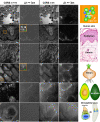Coherent Stokes Raman scattering microscopy (CSRS)
- PMID: 37286641
- PMCID: PMC10247746
- DOI: 10.1038/s41467-023-38941-4
Coherent Stokes Raman scattering microscopy (CSRS)
Abstract
We report the first implementation of laser scanning coherent Stokes Raman scattering (CSRS) microscopy. To overcome the major challenge in CSRS imaging, we show how to suppress the fluorescence background by narrow bandpass filter and a lock-in based demodulation. Near background free CSRS imaging of polymer beads, human skin, onion cells, avocado flesh and the wing disc of a drosphila larva are presented. Finally, we explain and demonstrate numerically that CSRS solves a major obstacle of other coherent Raman techniques by sending a significant part (up to 100%) of the CSRS photons into the backward direction under tight focusing conditions. We believe that this discovery will pave the way for numerous technological advances, e.g., in epi-detected coherent Raman multi-focus imaging, real-time laser scanning based spectroscopy or efficient endoscopy.
© 2023. The Author(s).
Conflict of interest statement
The authors declare no competing interests.
Figures





References
-
- Bunaciu A, Fleschin S, Aboul-Enein H. Infrared microspectroscopy applications—review. Curr. Anal. Chem. 2013;10:132–139. doi: 10.2174/1573411011410010011. - DOI
-
- Zumbusch A, Holtom GR, Xie XS. Three-dimensional vibrational imaging by coherent anti-stokes raman scattering. Phys. Rev. Lett. 1999;82:4142–4145. doi: 10.1103/PhysRevLett.82.4142. - DOI
-
- Nandakumar P, Kovalev A, Volkmer A. Vibrational imaging based on stimulated raman scattering microscopy. N. J. Phys. 2009;11:033026. doi: 10.1088/1367-2630/11/3/033026. - DOI
LinkOut - more resources
Full Text Sources

